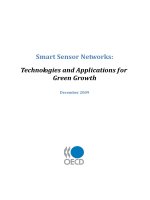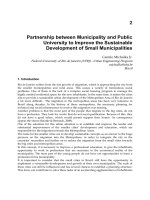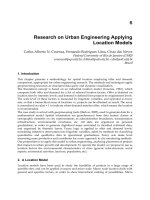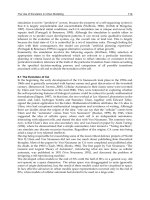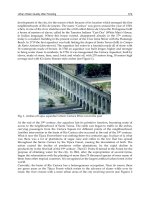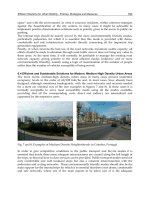Ebook Methods and reagents for green chemistry Part 2
Bạn đang xem bản rút gọn của tài liệu. Xem và tải ngay bản đầy đủ của tài liệu tại đây (9.24 MB, 144 trang )
8
FORMATION, MECHANISMS, AND
MINIMIZATION OF CHLORINATED
MICROPOLLUTANTS (DIOXINS)
FORMED IN TECHNICAL
INCINERATION PROCESSES
DIETER LENOIR , ERNST ANTON FEICHT , MARCHELA PANDELOVA,
AND KARL -WERNER SCHRAMM ,
¨ kologische Chemie, GSF-Forschungszentrum fu¨r Umwelt und Gesundheit,
Institut fu¨r O
Mu¨nchen, Germany
INTRODUCTION
Chlorinated micropollutants are harmful for man and environment due to their
toxicity, persistence, and bioaccumulation.1 Persistent compounds are very stable
and difficult to get metabolized and mineralized by biological and chemical processes in the environment, and as a result, they have become ubiquitous in water,
sediments, and the atmosphere; bioaccumulation is the result of the lipophilicity
of these compounds.1 Polychlorinated dibenzodioxins and -furans (PCDD/F) are
not produced purposely like many of other chlorinated technical products, such as
chlorinated biocides DDT, lindane, and toxaphene.2 The production and use of
persistent organic pollutants (POPs), the “dirty dozen” has now been banned
worldwide by the Stockholm protocol.3 It should be mentioned that about 3000
halogenated products have now been isolated as natural products in plants, microorganisms, and animals,4 but the total amount of these products is much smaller
compared to xenobiotics.
Methods and Reagents for Green Chemistry: An Introduction, Edited by Pietro Tundo, Alvise Perosa,
and Fulvio Zecchini
Copyright # 2007 John Wiley & Sons, Inc.
171
172
Pulp and paper
mills
Sewage sludge
incineration
Chemical
production
processes
Municipal waste
incineration
Hazardous waste
incineration
Hospital waste
incineration
Cement kilns
Metal smelting/
refining
Traffic (vehicle
fuel combustion)
Domestic
combustion
Combustion of
wood
Combustion of
coals and lignite
Combustion of oils
Outdoor burning of straw
Emission Source
5.4
39–399
4 (1–11)
19 (,1 –38)
10 (4– 16)
,1
70 (40 –230)
1.0
1.2
12
7.0
30
2.1
16
3.7
0.2
0.07
250
80 –240
460
382
0.5
0.3
Netherlands
(g I-TEQ/yr)
1.1
12.6
0.5–72
6 (2–10)
,1
5.4–432
3 (1–14)
3100–7400
7 (a)
0.01–1.1
,1
Japan
(g I-TEQ/yr)
40
Germany
(g I-TEQ/yr)
4
Austria
(g I-TEQ/yr)
TABLE 8.1 Estimates for Emissions of PCDD/F for Six Different Countries
2
1489
16
613
32
11
1150
United Kingdom
(g I-TEQ/yr)
113–1063 (c)
27–270 (d)
110–1100
75–745 (c)
1600–16000
11–110
1800–9000
10–52
United States
(g I-TEQ/yr)
173
112 (50–320)
1987–1988
67–926
1990
1.8
4000–8400
1990
20 (b)
16
3
Source: A. K. Djien Diem and J. A. van Zorge, ESPR-Environ. Sci. Pollut. Res., 1995.
a
Value represents total of incineration of sewage (5) and paper sludge (2).
b
Value represents lubrication oil.
c
Range represents total of secondary copper smelting (74– 740) and secondary lead smelting (0.7– 3.5).
d
Value represents diesel only.
e
Range represents total of industrial (100– 1000) and residential wood burning (13– 63).
Total
Basis year
Burning of cables
and electromotors
Drum and barrel
reclamation
Forest fires
Kraft black
liquor boilers
Cigarette smoking
Charcol briquette
combustion
Various high-temp.
processess
Crematoria
Accidental fires
(Former) use of
wood preservatives
484
1991
25
0.2
2.7
1.5
3870
1989
16
55
3300–26000
1994
27–270
0.9–4.3
0.5–5.0
174
FORMATION, MECHANISMS, AND MINIMIZATION
PCDD/F are formed and emitted from various thermal processes, such as
municipal and hazardous waste incinerators and metallurgy. They are transported
globally through the atmosphere and precipitated to the surfaces of plants, soils,
and water. In Table 8.1 the most important sources and amounts (inventories) for
PCDD/F are summarized for six countries.5 PCDD/F is a mixture of 210 compounds (see Figure 8.2). The 17 toxic isomers are expressed as a special sum parameter value, I-TE value (see the following definition). Besides the formation of
PCDD/F by thermal processes, these isomers have been found in the past as
by-products in technical products like chlorinated biphenyls (PCBs) and in technical grade pentachlorophenol (PCP). It should be mentioned that the amounts of
I-TE emitted from technical incinerators have decreased during the last decade in
many industrial countries due to strong legislative measures (ordinances such as
clean air acts). For example, most European countries have defined limit values of
0.1 ng I-TE/m3 for the emitted flue gas of waste incinerators. As a result, the estimated value of 400 g I-TE for German municipal waste incinerators for the year
1990 decreased to a value of 4 g I-TE in 1998. The United Nations Environmental
Program (UNEP) publishes up-to-date inventories of PCDD/F for the most important countries.6 It can be seen from Table 8.1, that pulp and paper mills today play
only a minor part in overall dioxin emissions, while PCDD/Fs are emitted by the
wastewater from these plants into the water of the rivers and seas.
8.1
FORMATION OF PCDD/F BY ACCIDENTS
All accidents concerned with PCDD/F are related to the production of chlorophenols.
The most famous accident happened in Seveso close to Milan, Italy, on July 10,
1976. ICMESA Corp. manufactured 2,4,5-trichlorophenol for production of phenoxyherbizides by alkaline hydrolysis of 1,2,4,5-tetrachlorobenzene (see Figure 8.1). This
Figure 8.1 Chemistry of the Seveso accident in 1976.
175
8.2 STRUCTURES, PROPERTIES, AND BEHAVIOR OF PCDD/F
process is a nucleophilic aromatic substitution of one chlorine atom by a hydroxi
group. Due to overheating of the vessel, exothermic condensation did occur instead
of substitution with the subsequent bursting of the valve of the apparatus. About
2.6 kg of 2,3,7,8-tetrachlorodibenzo-p-dioxin (TCDD) were released into the close
vicinity of the factory.
Dioxins are mainly by-products of industrial processes, but can also result from
natural processes, such as volcanic eruptions and forest fires. Besides the anthropogenic (man-made) sources of PCDD/F discussed earlier, biogenic and geogenic
sources for dioxins also have been discovered recently. In natural clays of the
kaolinite-type found in German mines in Westerwald, considerable levels of PCDD/
F have been detected;7 the same findings were obtained in special ball clays in the
Mississippi area of the United States.8 The pattern (isomeric ratios) of this natural
type of dioxins is different from the pattern obtained from incineration plants.
8.2
STRUCTURES, PROPERTIES, AND BEHAVIOR OF PCDD/F
The PCDD/F class consists of 210 compounds, 75 isomers of PCDD, and 135
isomers of PCDF. The number of regioisomers are the following according to the
number of chlorine atoms in either skeleton (see Table 8.2).
All PCDD/F isomers are solids with high melting points, but low vapor
pressure and low solubility in water. The high octanol – water coefficients are an
indication of the observed bioaccumulative behavior in plants and animals for
these compounds. Detailed environmentally important physicochemical properties
can be found in the literature.9 All higher chlorinated compounds are very persistent in the environment with half-lives of 5 –10 years; photolysis with sunlight is
the only degradation process in the environment.
Identification and quantification is obtained by combined high-resolution gas
chromatography/mass spectrometry (GC/MS) methods after special cleanup procedures of the matrix, as shown later for sediments (see Figure 8.2). The cleanup
methods for other matrices are similar. Quantification is obtained by addition of
13-C labeled standards before the cleanup procedure. In general, only the toxic
isomers are identified and quantified.
TABLE 8.2 Number of Regioisomers for PCDD and PCDF
Chlorine Substitution
PCDD
PCDF
Mono
Di
Tri
Tetra
Penta
Hexa
Hepta
Octa
2
10
14
22
14
10
2
1
4
16
28
38
28
16
4
1
Total
75
135
176
FORMATION, MECHANISMS, AND MINIMIZATION
Figure 8.2 Scheme for the cleanup method of PCDD/F in sediments.
All 210 isomers of PCDD/F have been prepared by standard synthetic routes
(see recent review.10). But none of the dioxins or furans are used for any practical
purpose. OCDD had been prepared in 1872 by Merz and Weith, but without
knowledge of the structure. Unsubstituted dibenzodioxin was prepared in 1906 by
Ullmann and Stein. 2,3,7,8-TCDD as well as OCDD were synthesized in 1957 by
W. Sandermann by electrophilic chlorination of unsubstituted dibenzodioxin. His
group prepared about 15 g of 2,3,7,8-TCDD unintentionally and discovered its
toxic behavior on themselves. Dr. Sorge, a medical doctor working for Boehringer
Corporation in Hamburg showed the toxicity of 2,3,7,8-TCDD prepared and
identified by W. Sandermann. At the same time about 30 workers of Boehringer
were engaged in commercial production of trichlorophenol for further production
of phenoxy herbicides (see Figure 8.1) and suffered from a severe illness that
resembled chloracne and related symptoms. Later it was shown that these technical products were contaminated with traces of 2,3,7,8-TCDD. Trace analysis for
PCDD/F did not exist at this time. It should be mentioned that the “Vietnam syndrome” can be traced back to the same cause: technical grade Agent Orange, a
8.4 POLLUTANTS IN INCINERATIONS
177
defoliant used during the war, was contaminated with traces of 2,3,7,8-TCDD,
resulting in the severe illness of a large number of veterans.
8.3
TOXICOLOGY
PCDD and PCDF short-term exposure to humans in high levels may result in skin
lesions, such as chloracne and patchy darkening of the skin, and altered liver
function. Long-term exposure is linked to impairment of the immune system, the
developing nervous system, the endocrine system, and reproductive functions.
Chronic exposure of animals to dioxins has resulted in several types of cancer.
TCDD was evaluated by International Agency for Research on Cancer (IARC) in
1997. Based on human epidemiology data, dioxin was categorized by IARC as a
“known human carcinogen.” However, TCDD does not affect genetic material
and there is a level of exposure below which cancer risk would be negligible.
Toxic behavior of PCDD/F is a complex matter. Contrary to other poisons,
LC-50 (lethal concentration) values that were studied for acute toxicity for a
variety of mammals depend largely on the species being investigated. The value
(in mg/kg) varies from 0.6 for guinea pigs to 300 for hamsters. For man a LC-50
value larger than 2000 has been estimated. In addition, 2,3,7,8-TCDD shows
strong cancerogenic effects when administered to mice and rats. The toxic mechanism is a special binding to the Ah receptor of DNA.11 2,3,7,8-TCDD is the
most toxic isomer among the 17 isomers with the 2,3,7,8 pattern (see Table 8.3).
These values are obtained by enzyme-induction test studies. Properties of endocrine disruption are most likely.
The dioxin toxic equivalency factor (TEF) approach is currently used worldwide for assessing and managing the risks posed by exposure to mixtures of
certain dioxin-like compounds (DLCs).12b – 12e World Health Organization-TEF
(WHO-TEF) values have been established for humans and mammals, birds, and
fish.12b,12f (For new, refined values, see Ref. 12g.) It should be mentioned that 16
PCBs, the coplanar isomers with nonortho, monoortho, and diortho substitution
by chlorine (overall, there are 209 isomers for this class of compounds) show
dioxin-like toxic behavior. I-TE values are smaller, in the range of 0.0001 – 0.1.
The most toxic isomers is 3,30 ,4,40 ,5-pentachlorodiphenyl with I-TE of 0.1.13
Polybrominated dibenzodioxins and furans with the 2,3,7,8 pattern also show
dioxin-like toxicity, but their I-TE values are lower compared to PCDD/F.
8.4 POLYCHLORINATED DIBENZODIOXINS AND FURANS
AS POLLUTANTS FORMED IN INCINERATIONS
8.4.1 Primary and Secondary Measures for Minimization of PCDD/F
in Incineration Plants
PCDD/F are emitted by the flue gas of the incineration plants. Primary measures
have become very important in the production and technology of chemistry as the
178
FORMATION, MECHANISMS, AND MINIMIZATION
TABLE 8.3 Toxic Equivalency Factors (TEFs) for Toxic PCDD/F
Isomers According to NATO/CCMS (1988) and WHO I-TE
Structure
I-TE-value
NATO/
CCMS
1988
WHO-TEF
Structure
I-TE-value
NATO/
CCMS
1988e
WHO-TEF
1
1
0.1
0.1
0.5
1
0.01
0.01
0.1
0.1
0.001
0.001
0.1
0.1
0.1
0.1
0.1
0.1
0.05
0.05
0.1
0.1
0.5
0.5
0.01
0.01
(Continued)
179
8.4 POLLUTANTS IN INCINERATIONS
TABLE 8.3 Continued
0.1
0.1
0.01
0.01
0.1
0.1
0.001
0.0001
Source: Landers J. P. and Bunce, N. J. Biochem. J., 1991,12a and van den Berg M. et al., Environ.
Health Perspect., 1998.12b
principal tool for the protection of the environment. They are related to the principles of green chemistry applied in industrial chemistry, called process-integrated
protection of the environment.14 The process in itself is designed to run without or
with a minimum formation of pollutants. For incineration plants, this goal can be
maintained by the following parameters, called good burning praxis (gbp):15a,15b
Optimal burning temperature
Optimal lambda value (air/fuel ratio)
Optimal residence time of fuel in the flame, in general, regulated by turbulence
For either plant type, incineration, or fuel type, these factors must be empirically
determined and controlled. Because dioxins as effluents are concerned, it is possible to reduce I-TE values from about 50 ng/m3 to about 1 ng/m3. Additional secondary measures (filter techniques) are therefore necessary for obtaining the lower
limit value of 0.1 ng/m3. Secondary measures are special filter techniques for pollutants formed in nongreen processes, also called end-of-pipe technology.16 The
main part of technical incineration plants consists of filter devices, mostly coke as
adsorbent is used, which must be decontaminated later by itself by burning in
hazardous-waste incinerators. The inhibition technology, discussed later, is related
on principles of primary (green) measures for a clean incineration method.
8.4.2
Thermal Formation Mechanisms of PCDD/F
The specific mechanisms of PCDD/F formation in incineration processes are very
complex.17a,17b Knowledge of the formation mechanisms of micropollutants
allows the development of special minimization techniques and improvement of
the whole process, therefore the study of formation mechanisms of toxic side products formed in chemical production is also a contribution to green chemistry.
180
FORMATION, MECHANISMS, AND MINIMIZATION
PCDD/F and other chlorinated hydrocarbons observed as micropollutants in
incineration plants are products of incomplete combustion like other products
such as carbon monoxide, polycyclic aromatic hydrocarbons (PAH), and soot.
The thermodynamically stable oxidation products of any organic material formed
by more than 99% are carbon dioxide, water, and HCl. Traces of PCDD/F are
formed in the combustion of any organic material in the presence of small
amounts of inorganic and organic chlorine present in the fuel; municipal waste
contains about 0.8% of chlorine. PCDD/F formation has been called “the inherent
property of fire.” Many investigations have shown that PCDD/Fs are not formed
in the hot zones of flames of incinerators at about 10008C, but in the postcombustion zone in a temperature range between 300 and 4008C.17a Fly ash particles
play an important role in that they act as catalysts for the heterogeneous formation
of PCDD/Fs on the surface of this matrix. Two different theories have been
deduced from laboratory experiments for the formation pathways of PCCD/F:
1. De novo Theory: PCDD/Fs are formed from particulate (elementary)
carbon species found in fly ash in the presence of inorganic chlorine of this
matrix,
2. Precursor Theory: PCDD/Fs are formed from chemically related compounds as precursors. Chemically related products of PCDD/Fs are chlorophenols and chlorobenzenes. Both classes of compounds are present in the
effluents of incinerators and can adsorb from the stack gas to the fly ash.17b
Both pathways have been shown to be relevant for PCDD/F formation in
municipal-waste incinerations. Chlorophenols can be converted to PCDD by
copper species known in synthetic chemistry as the Ullmann type II coupling reaction. By use of isotope labeling techniques in competitive concurrent reactions with
both reactions performed in laboratory experiments it was shown that precursor
theory pathways from chlorophenols may be more important compared to the de
novo pathway, but either competing pathway strongly depends on such conditions
as temperature, air flow rate, and residence time.17 It may be difficult to model the
complex reality of large incinerators using relevant laboratory experiments.
Recently, a general mechanistic scheme for most chlorinated compounds,
including PCDD/F, observed in the effluents of incinerators was proposed using a
special flow reactor (turbular furnace reactor) with acetylene as the starting
material, and CuCl2 and CuO as the most active catalytic components of fly ash
(see Figure 8.3). The mechanism is based on ligand transfer chlorination of acetylene by copper chloride, leading to dichloroacetylene as the starting steps.
Dichloroacetylene then condenses to a number of condensation products, such as
various perchlorinated aliphatic and aromatic compounds,18a – 18b (see Figure 8.3).
Hexachlorobenzene, shown in Figure 8.3, reacts further to chlorophenols and
PCDD/F, which stay adsorbed on the copper species but can be further
extracted19 in the turbular furnace reactor. All low volatile chlorinated compounds shown in Figure 8.3 are eluted with the gas flow. The lower
8.4 POLLUTANTS IN INCINERATIONS
181
Figure 8.3 Scheme for global acetylene chlorination/condensation mechanism leading to
hexachlorobenzene. (From A. Wehrmeier et al., Environ. Sci. Technol., 1998.)
chlorinated isomers observed in the effluents are the result of subsequent
dechlorination processes. Both classes of chlorine compounds have also been
detected in the effluents of incinerators, Chlorobenzenes (CBs) and chlorophenols (CPs) are found in the stack gas of incinerators, but in much higher concentrations, showing a linear relationship with concentrations of PCDD/F. CBs
and CPs have been used as indicator parameters for PCDD/Fs.20a,20b Chlorinated benzenes have been measured on-line by resonance enhanced multi-photon
ionization (REMPI) spectroscopy in stack and flue gases of incinerators. This
technique allows a direct and easy-to-do indirect estimation of PCDD/F concentrations in the effluents of incinerators.20a PCDD/F values are generally the result
of a measurement during a sampling period of 6 hours, yielding an average value
for PCDD/F for this time interval. Since a direct time control for PCCD/F is
possible by measurement of indicator compounds an affected plant can be
cleansed, for example, by the addition of more air (increase of the lambda value).
182
FORMATION, MECHANISMS, AND MINIMIZATION
Figure 8.4 Ratio of tetrachlorinated dioxin isomers from a large variety and number of
incineration samples. (From A. Wehrmeier et al., Chemosphere, 1998.)
Figure 8.5 Observed and calculated reaction pathways from aliphatic C6Cl8-species to
hexachlorobenzene. Numbers are values (KJ/mol) calculated by B3LYP/6-31G(2d). (From
H. Detert et al., to be published.)
8.4 POLLUTANTS IN INCINERATIONS
183
The relative ratio of regioisomers of PCDD/F and other chlorinated compounds formed in incinerators is called the incineration pattern. The pattern can
be derived from statistical analysis of a large number of measurements of the
same plants, and can be used for elucidation of thermal formation mechanisms in
plants. In principle regioisomers can be formed either by stereospecific chlorination or dechlorination processes. The pattern has also been used as a part for
explaining of the formation mechanism of PCDD/F and other chlorinated compounds formed in incinerations21 (see Figure 8.4).
A more detailed mechanistic study was performed recently for the thermal conversion of perchlorinated aliphatic C-6 polyenes like C6Cl8 into hexachlorobenzene22 (see Figure 8.5).
8.4.3 Inhibition Technology as Primary Measure for
PCDD/F Minimization
As a consequence of the detection of catalytic pathways for formation of
PCDD/F, special inhibition methods have been developed for PCDD/F. By this
approach the catalytic reactions are blocked by adding special inhibitors as “poisoning” compounds for copper and other metal species in the fly ash. Special aliphatic amines (triethylamine) and alkanolamines (triethanolamine) have been
found to be very efficient as inhibitors for PCDD/F, and have been used in pilot
plants. The effect can be seen in Figure 8.6. The inhibitors have been introduced
into the incinerator by spraying them into the postcombustion zone of the incinerator at about 4008C.23a – c
These amines used as inhibitors show negative side effects (disturbances) when
used for larger plants. They can be regarded as pollutants by themselves, and can
disturb special devices in the plants, especially, when used on a larger scale,
filters like electrostatic precipitators. Therefore, we have improved the inhibition
method by the use of much safer inorganic compounds as inhibitors, such as,
Figure 8.6 Effect of aliphatic amines addition as inhibitors on PCDD/F concentration
¨ kotox., 1989.)
(measured on fly ash). (From D. Lenoir et al., Umweltchem. O
184
FORMATION, MECHANISMS, AND MINIMIZATION
sulfamide and amido sulfonic acid, which can be added directly to the fuel and
survive the hot area of the flames before entering the postcombusting zone.24,25 In
a recent study, incineration of lignite coal/solid waste/polyvinyl chloride (PVC)
was used in a laboratory-scale furnace in order to study the prevention of PCDD/
F formation by inhibitors.25 Nineteen inhibitors divided into four different types
of groups (metal oxides, N-containing compounds, S-containing compounds, and
N- and S-containing compounds) according to their chemical nature were tested.
The total amounts of PCDD/F generated during the experiments with lignite coal,
solid waste, and PVC are high enough to investigate a greater inhibition. The
average I-TEQ value of the sum of PCDD/F is about 15 pg/g fuel (see
Figure 8.7). A relatively low inhibitory effect is observed for the substances that
contain only nitrogen. However, higher reduction effects of PCDD/F can be
derived for the S-containing substances present in 10% of the fuel. Sulfur itself
shows a very strong inhibition effect for PCDD/F. It is already known that sulfur
is converted into SO2 and that it reduces Cl2 to HCl, and therefore dioxin and
PCB formation can be reduced.26 Also because of this mechanism, the rest of the
S-containing compounds probably, inhibit PCDD/F flue gases. Although the
single N- and S-containing compounds are not very effective as inhibitors, all
other N- and S-containing substances seem to be able to greatly reduce PCDD/F
flue gas emission if used as a 10% additive to lignite coal, solid waste, and PVC
as fuel. A mixture of (NH2)2COþS (1:1) can successfully inhibit PCDD/F toxic
gases. However, the most effective inhibitors for PCDD/F are (NH4)2SO4 and
(NH4)2S2O3. Both compounds can reduce the PCDD/F emission up to 98– 99%.
In addition, (NH4)2SO4 and (NH4)2S2O3 were used at 5, 3, and 1% of the fuel.
The results show that both substances are still effective inhibitors of PCDD/F formation at 5% and 3% of the fuel (see Figure 8.8).
If the percentage of these substances is decreased further, the suppressing effect
of dioxin formation will also decrease. (NH4)2SO4 might also reduce the PCDD/F
Figure 8.7 PCDD/F I-TEQ (pg/g) values of flue gas after the combustion of lignite coal,
solid waste, and PVC in the samples without inhibitor and 19 different compounds used
with a 10% inhibitor of the fuel. (From M. Pandelova et al., Environ. Sci. Technol., 2005.)
8.5 CONCLUSION
185
Figure 8.8 PCDD/F I-TEQ pg/g fuel values in flue gas for the samples without an
inhibitor and with (NH4)2SO4 and (NH4)2S2O3 as inhibitors of the fuel at 10%, 5%, 3%,
and 1%.
flue-gas emission up to 90%, even at 3% of the fuel. (NH4)2SO4 is a low-cost and
nontoxic material. That makes it suitable for use in full-scale combustion units.
Inhibition technology also has been used recently by two other groups.27,28
Urea as an aqueous solution added to the fuel has been found to be very effective
as an inhibitor of PCDD/F in a pilot and technical plant. Furthermore, other
N-compounds and S-compounds, such as sulfur dioxide, ammonia, dimethylamine, and methyl mercaptan sprayed as gaseous inhibitors in the flue gas, seem to
be a promising technique for preventing the formation of PCDD/F in waste
incineration.
8.5
CONCLUSION
An important principle in green chemistry is the avoidance of pollutants formed
in chemical processes by the use of primary measures. This approach is shown in
this chapter for dioxins formed in incinerations. Concentration of PCDD/F in
various parts of the environment has increased during the last few decades as
result of an increase in use of different technical thermal processes. Therefore, relevant formation mechanisms for PCDD/F have been studied, showing the importance of copper species in inducing catalytic pathways from aliphatic precursors
like acetylene in the postcombustion zone at about 3008C. Now, indicator parameters for PCDD/F like chlorobenzenes can be measured on-line, allowing for
the cleansing of the plants. The inhibition technology uses the addition of special
compounds to block the active sites of copper in the fly ash of incinerators.
PCDD/F concentrations are slowly decreasing in the environment due to primary
measures discussed in this chapter in combination with advanced filter devices as
secondary measures at incineration plants.
186
FORMATION, MECHANISMS, AND MINIMIZATION
REFERENCES
1. Alloway, B. J.; Ayres, D. C. Schadstoffe in der Umwelt, Chemische Grundlagen zur
Beurteilung von Luft-, Wasser-, und Bodenverschmutzungen (Chemical Principles of
Environmental Pollutants), Spektrum Verlag, Heidelberg, 1996.
2. Ramamoorthy, S.; Ramamoorty, S. Chlorinated Organic Compounds in the Environment, Regulary and Monitoring Assessment, Lewis Publishers, Boca Raton, Fla.,
1997.
3. Schlottmann, U.; Kreibich, M. Nachrichtenbl. Chem., 2001, 49, 608; see also,
www.chem.unep.ch/pops/
4. Gribble, G. W. Acc. Chem. Res., 1998, 31, 141.
5. Djien Diem, A. K.; van Zorge, J. A. ESPR-Environ. Sci. Pollut. Res., 1995, 2, 46.
6. Dioxin and Furan Inventories, National and Regional Emissions of PCDD/PCDF,
United Nations Environmental Program, Prepared by UNEP Chemicals, Geneva,
Switzerland, most recent issue, May 1999.
¨ kotox., 2000, 12, 2.
7. Jobst, H.; Aldag, R. UWSF-Z. Umweltchem. O
8. Ferrario, J. B.; Byrne, C. J.; Cleverly, D. H. Environ. Sci. Technol., 2000, 34, 4524.
9. Mackay, D.; Shiu, W. Y.; Ma, K. C. Illustrated Handbook of Physical-Chemical
Properties and Environmental Fate for Organic Chemicals, Vol. II, Polynuclear Aromatic Hydrocarbons, Polychlorinated Dioxins, and Dibenzofurans, Lewis Publishers,
Boca Raton, Fla., 1992.
10. Parlar, H.; Angerho¨fer, D. Dioxins and annulated derivatives, in Houben-Weyl, Vol.
E, Hetarenes IV, Thieme, Stuttgart, 1997.
11. Safe, S.; Hutzinger, O.; Hill, T. A. (Eds.) Polchlorinated Dibenzo-p-Dioxins and
-Furans (PCDDs/PCDFs). Sources and Environmental Impact, Epidemiology, Mechanisms of Action, Health Risks, Environmental Toxin Series 3, Safe, S.; Hutzinger,
O. (Eds.) Springer, Berlin, 1990.
12a. Landers, J. P.; Bunce, N. J. The Ah receptor and the mechanism of dioxin toxicity
(Review), Biochem. J., 1991, 276, 273.
12b. Van den Berg, M.; Birnbaum, L.; Bosveld, A. T. C. et al., Environ Health Perspect.,
1998, 106, 775.
12c. Ahlborg, U. G.; Brouwer, A.; Fingerhut, M. A. et al., Eur. J. Pharmacol., 1992, 228,
179.
12d. DeVito, M. J.; Diliberto, J. J.; Ross, D. G. et al., Toxicol., Appl. Pharmacol., 1997,
147, 267.
12e. Safe, S. H. Crit. Rev. Toxicol., 1990, 21, 519.
12f. Ahlborg, U. G.; Becking, G. C.; Birnbaum, L. S. et al., Chemosphere, 1994, 28, 1049.
12g. van den Berg, M.; Birnbaum, L. S.; Denison, M. et al. The 2005 World Health
Organization re-evaluation of human and mammalian toxic equivalency factors for
dioxins and dioxin-like compounds, Toxicol. Sci., 2006, 93, 223–241.
13. Ahlborg, U. G.; Becking, G. C.; Birnbaum, L. S. et al., Chemosphere, 1994, 28,
1049.
14. Christ, C. (Ed.) Production-Integrated Environmental Protection and Waste Management in the Chemical Industry, Wiley-VCH, Weinheim, Germany, 1999.
15a. Lenoir, D.; Kaune, A.; Hutzinger, O. et al., Chemosphere, 1991, 23, 1491.
REFERENCES
15b.
16.
17a.
17b.
18a.
18b.
19.
20a.
20b.
21.
22.
23a.
23b.
23c.
24.
25.
26.
27.
28.
187
McKay, G. Chem. Eng. J., 2002, 86(3), 343.
Kaune, A.; Lenoir, D.; Nikolai, U. et al., Organohalogen Compounds, 1995, 23, 477.
Stanmore, B. R. Combust. Flame, 2004, 136, 398.
Dickson, L. C.; Lenoir, D.; Hutzinger, O. Environ. Sci. Technol., 1992, 26, 1822.
Wehrmeier, A.; Lenoir, D.; Sidhu, S. et al., Environ. Sci. Technol., 1998, 32, 2741.
Taylor, H. P.; Lenoir, D. Sci. Total Environ., 2001, 269, 1.
Taylor, P.; Wehrmeier, A.; Sidhu, S. S. et al., Chemosphere, 2000, 40, 1297.
Kaune, A.; Lenoir, D.; Schramm, K.-W. et al., Environ. Engi. Sci., 1998, 15, 85.
Blumenstock, M.; Zimmermann R.; Schramm K.-W.; Kettrup A. Chemosphere, 2001,
42, 507.
Wehrmeier, A.; Lenoir, D.; Schramm, K.-W. et al., Chemosphere, 1998, 36, 2775.
Detert, H.; Zipse, H.; Lenoir, D., to be published.
Lippert, T.; Wokaun, A.; Lenoir, D. Environ. Sci. Technol., 1991, 25, 1485.
Dickson, L. C.; Lenoir, D.; Hutzinger, O. et al., Chemosphere, 1989, 19, 1435.
¨ kotox., 1989,
Lenoir, D.; Hutzinger, O.; Mu¨tzenich, G.; Horch, K. Umweltchem. O
4, 3.
Samaras, P.; Blumenstock, M.; Lenoir, D. et al., Environ. Sci. Technol., 2000, 34,
5092.
Pandelova, M.; Lenoir, D.; Kettrup, A.; Schramm, K.-W. Environ. Sci. Technol.,
2005, 39, 3345.
Gullett, B.; Bruce, K. R.; Beach, L. O. Environ. Sci. Technol., 1992, 26, 1938.
Ruokojarvi, P. H.; Asikainen, A. H.; Tuppurainen, K. A.; Ruuskanen, J. Sci. Total
Environ., 2004, 325, 83.
Kuzuhara, S.; Sato, H.; Tsubouchi, N. et al., Environ. Sci. Technol., 2005, 39, 795.
PART 3
GREEN CATALYSIS AND
BIOCATALYSIS
9
GREEN CHEMISTRY: CATALYSIS
AND WASTE MINIMIZATION
ROGER A. SHELDON
Delft University of Technology, Delft, The Netherlands
INTRODUCTION
A growing environmental awareness and increasingly stringent environmental
legislation have focused the attention of chemical manufacturers on what has
become known as sustainable development or green chemistry. A working
definition of green chemistry is: Technologies that efficiently utilize energy and
(preferably renewable) raw materials and reduce, or preferably, eliminate, the
generation of waste and avoid the use of toxic and/or hazardous reagents and
solvents. This is actually very close to and has the same meaning as the definition
given by the International Union of Pure and Applied Chemistry’s (IUPAC’s)
working party on green chemistry. The emphasis is placed clearly on the
reduction (elimination) of waste at the source, that is, primary pollution prevention rather than incremental, end-of-pipe solutions (waste remediation). A direct
consequence of this trend toward green chemistry is that traditional concepts of
process efficiency, based exclusively on chemical yield, are being replaced by a
new paradigm that assigns economic value to eliminating waste and avoiding the
use of toxic and/or hazardous chemicals.1 – 4
9.1
E FACTORS AND ATOM EFFICIENCY
Two useful measures of the potential environmental impact of chemical processes
are the E-factor,5 – 7 defined as the mass ratio of waste to desired product, and the
Methods and Reagents for Green Chemistry: An Introduction, Edited by Pietro Tundo, Alvise Perosa,
and Fulvio Zecchini
Copyright # 2007 John Wiley & Sons, Inc.
191
192
GREEN CHEMISTRY: CATALYSIS AND WASTE MINIMIZATION
TABLE 9.1 E-factors for Different Segments of the Chemical Industry
Industry Segment
Oil refining
Bulk chemicals
Fine chemicals
Pharmaceuticals
Production (tons)
6
8
10 –10
104 –106
102 –104
10 –103
E-Factor kg Waste/kg Product
ca. 0.1
,1– 5
5–50
25 –.100
atom efficiency,1,2 calculated by dividing the molecular weight of the product by
the sum of the molecular weights of all substances produced in the stoichiometric
equation.
A prime cause of high E-factors is the use of stoichiometric inorganic reagents.
Fine chemicals and pharmaceuticals manufacture, for example, is rampant with
classic stoichiometric technologies that generate copious amounts of inorganic
salt as waste. Examples that readily come to mind are stoichiometric reductions
with metals (Zn, Fe) and metal hydrides (NaBH4, LiAlH4, and derivatives
thereof ) and stoichiometric oxidations with permanganate, dichromate, periodate,
and so forth. Similarly, processes employing mineral acids (H2SO4, HF), Lewis
acids (AlCl3, ZnCl2, BF3), or inorganic bases (NaOH, K2CO3), often in stoichiometric amounts, represent a major source of inorganic waste that cannot easily be
recycled. Reactions of this type, widely employed in the fine chemical industry,
include Friedel – Crafts acylation mediated by Lewis acids such as AlCl3, sulfonations, and diazotizations, to name but a few.
The workup for such reactions involves neutralization and concomitant generation of salts such as NaCl, Na2SO4, and (NH4)2SO4. The elimination of such waste
streams and a reduction in the dependence on the use of hazardous chemicals, such
as phosgene, dimethyl sulfate, peracids, sodium azide, halogens, and HF, are
primary goals in green chemistry.
Table 9.1 contains the values of E-factors (mass ratio of waste to desired
product) for different industry segments; most of the processes for fine chemicals
and pharmaceuticals, with a very large E-factor, use reagents in stoichiometric
quantities, often in combination with environmentally unfriendly solvents. The
E-factor is the actual amount of waste formed in the process and includes everything except the desired product, not only the raw materials and reagents involved
in the stoichiometric equation but also chemicals used in the workup, for
example, acids and bases for neutralization, and solvent losses. Strictly speaking,
it should also include the fuel used to generate the energy required to operate the
process, but this is often difficult to quantify. Process water is not included, as
this leads to E-factors that are not generally meaningful.
9.2
THE ROLE OF CATALYSIS
The increasing use of catalytic processes can substantially reduce waste at the
source, resulting in primary pollution prevention. The theoretical process efficiency
9.2 THE ROLE OF CATALYSIS
193
Figure 9.1 Acetophenone synthesis by stoichiometric and catalytic oxidation.
can be quantified by the atom efficiency, the ratio between the molecular weight of
the product, and the sum of the molecular weights of all substances produced in the
stoichiometric equation. It should be pointed out, however, that the atom efficiency
only takes the chemicals appearing in the stoichiometric equation into account.
Figure 9.1 compares the synthesis of acetophenone by classic oxidation of
1-phenylethanol with stoichiometric amounts of chromium oxide and sulphuric
acid, with an atom efficiency of 42%, with the heterogeneous catalytic oxidation
with O2, with an atom efficiency of 87%, and with water as the only by-product.
This is especially important if we consider the environmental unfriendliness of
chromium salts: the potential environmental impact of reactions can be expressed
by the environmental quotient (EQ), where E is the E-factor (kg waste/kg
product) and Q is the environmental unfriendliness quotient of the waste. If Q is
Figure 9.2 Atom-efficient catalytic processes.
194
GREEN CHEMISTRY: CATALYSIS AND WASTE MINIMIZATION
Figure 9.3 Friedel –Crafts acylation of anisole.
1 for NaCl, for example, then for chromium salts Q could be arbitrarily set at, say
100 or 1000. Similarly, clean catalytic technologies can be utilized for hydrogenation of acetophenone and carbonylation of 1-phenylethanol (Figure 9.2), with
100% atom efficiency in both cases.
One way to significantly reduce the amount of waste is to substitute traditional
mineral acids and Lewis acids with recyclable solid acid catalysts. A good
example of this is the Rhodia process for the synthesis of 4-methoxy acetophenone by Friedel – Crafts acetylation of anisole (Figure 9.3) with acetic anhydride,
catalyzed by the acid form of zeolite beta.8 This replaced a traditional Friedel –
Crafts acylation using acetyl chloride in combination with more than one equivalent of aluminium chloride in a chlorinated hydrocarbon solvent. The new process
requires no solvent and avoids the generation of HCl in both the acylation and the
synthesis of the acetyl chloride. The original process generated 4.5 kg of aqueous
effluent (containing AlCl3, HCl, chlorinated hydrcarbon residues, and acetic acid)
per kg of product. The catalytic alternative generates 0.035 kg of aqueous effluent
(i.e., .100 times less), consisting of 99% water, 0.8% acetic acid, and ,0.2%
other organics per kg of product . Workup consists of catalyst filtration and distillation of the product. Because of the simpler process, a higher chemical yield is
obtained (.95% vs. 85–95%) and higher product purity is obtained. Moreover, the
catalyst is recyclable and the number of unit operations is reduced from 12 to 3.
The conclusion is clear: The new technology is not only cleaner and greener, it
also leads to lower production costs than the classic process. An important lesson
indeed.
Other important successes have been achieved in developing clean, “green,”
methods to oxidize alcohols, for example, the Ru/TEMPO (tetramethylpiperidinyloxyl radical) catalysis, shown in Figure 9.4, for the aerobic oxidation of
alcohols.9
9.3 CATALYSIS IN WATER
195
Figure 9.4 Aerobic oxidation of primary and secondary alcohols catalyzed by RuCl2
(Ph3P)3/TEMPO in PhCl at 1008C.
9.3
CATALYSIS IN WATER
Another environmental issue is the use of organic solvents. The use of chlorinated
hydrocarbons, for example, has been severely curtailed. In fact, so many of the
solvents favored by organic chemists are now on the black list that the whole
question of solvents requires rethinking. The best solvent is no solvent, and if
a solvent (diluent) is needed, then water has a lot to recommend it. This provides
a golden opportunity for biocatalysis, since the replacement of classic chemical
methods in organic solvents by enzymatic procedures in water at ambient
temperature and pressure can provide substantial environmental and economic
benefits. Similarly, there is a marked trend toward the application of organometallic catalysis in aqueous biphasic systems and other nonconventional media, such
as fluorous biphasic, supercritical carbon dioxide and ionic liquids.10
A prime advantage of such biphasic systems is that the catalyst resides in one
phase and the starting materials and products are in the second phase, thus providing for easy recovery and recycling of the catalyst by simple phase separation. A
pertinent example is the aerobic oxidation of alcohols catalyzed by a watersoluble Pd-bathophenanthroline complex (Figure 9.5).11 The only solvent used is
water, the oxidant is air, and the catalyst is recycled by phase separation.
The Boots Hoechst Celanese (BHC) ibuprofen process12 involves palladiumcatalyzed carbonylation of a benzylic alcohol (IBPE). More recently, we performed this reaction in an aqueous biphasic system using Pd/tppts as the catalyst
(Figure 9.6; tppts ¼ triphenylphosphinetrisulfonate). This process has the advantage of easy removal of the catalyst, resulting in less contamination of the
product.
